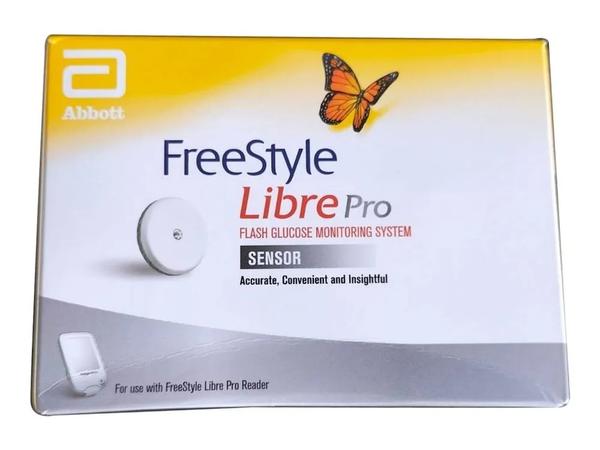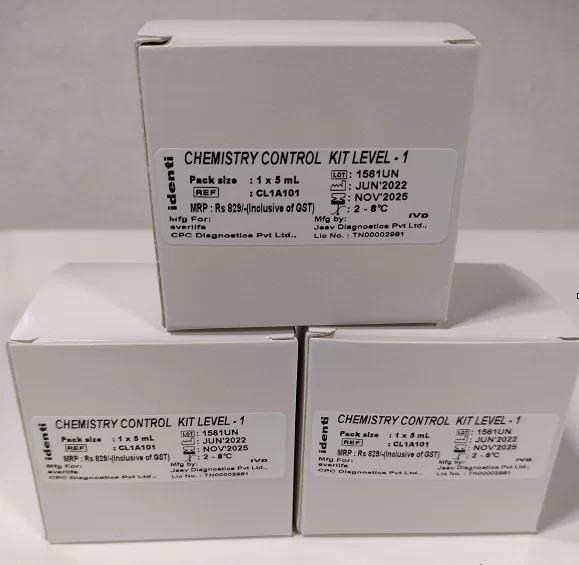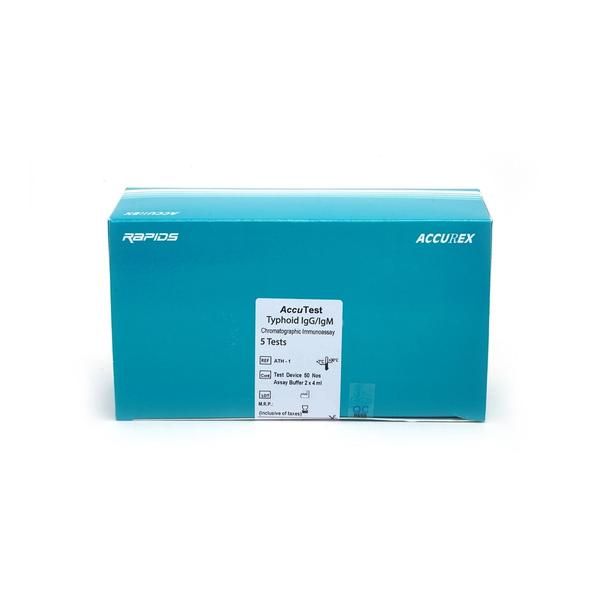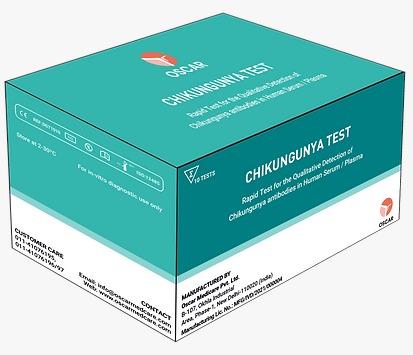Rapid Test
Buy AccuTest Typhoid IgG/IgM Rapid Card Test (5 Tests) Online from Accurex. The Typhoid IgG/IgM Rapid Test is used for detection & differentiation of anti-Salmonella typhi (S. typhi) IgG and IgM in human whole blood / serum / plasma. This Typhoid test is used as a screening test and as an aid in the diagnosis of infection with S. typhi. Salmonella typhi bacteria causes typhoid Typhoid fever, typhoid symptoms symptoms are likely to develop gradually – appearing one to three weeks after exposure to the disease. There are various typhoid treatment & typhoid vaccine which can be opted after the detetction of Typhoid.
Typhoid fever is caused by S. typhi, a Gram-negative bacterium. Worldwide an estimated 17 million cases and 600,000 associated deaths occur annually. Patients who are infected with HIV are at significantly increased risk of clinical infection with S. typhi. Evidence of H. pylori infection also presents an increased risk of acquiring typhoid fever. 1-5% of patients become chronic carrier harboring S. typhi in the gall bladder. The clinical diagnosis of typhoid fever depends on the isolation of S. typhi from blood, bone marrow or a specific anatomic lesion. In the facilities that can not afford to perform this complicated and time-consuming procedure, Filix-Widal test is used to facilitate the diagnosis. However, many limitations lead to difficulties in the interpretation of the Widal test. In contrast, the Typhoid IgG/IgM Rapid Test is a simple and rapid laboratory test. The test simultaneously detects and differentiates the IgG and the IgM antibodies to S. typhi specific antigen thus to aid in the determination of current or previous exposure to the S. typhi.
PRINCIPLE
The Typhoid IgG/IgM Rapid Test is a lateral flow immunochromatographic assay. The test cassette consists of: 1) a pink-purple colored conjugate pad containing recombinant S. typhi H antigen and O antigen conjugated with colloid gold (Typhoid conjugates) and rabbit IgG-gold conjugates, 2) a nitrocellulose membrane strip containing two test region (Test line M and G) and a control region (control line). The test line ‘M’ is pre-coated with monoclonal anti-human IgM for the detection of IgM anti-S. typhi, test line
‘G’ is pre-coated with monoclonal anti-human IgG for the detection of IgG anti-S. typhi , and the C band is pre-coated with goat anti rabbit IgG. When an adequate volume of test specimen is dispensed into the sample well of the cassette, the test specimen migrates by capillary action across the test cassette. Anti-S. typhi IgM if present in the patient specimen will bind to the Typhoid conjugates. The immunocomplex is then captured on the membrane by the pre-coated anti-human IgM antibody at test region
‘M’, forming a pink-purple line at ‘M’ region, indicating a S. typhi IgM positive test result.
Anti-S. typhi IgG if present in the patient specimen will bind to the Typhoid conjugates. The immunocomplex is then captured by the pre-coated reagents on the membrane, forming a pink-purple line at test region ‘G’, indicating a S. typhi IgG positive test result. Absence of any pink-purple line at test region (M and G) suggests a negative result. The test contains an internal control (control line) which should exhibit a pink-purple line of the immunocomplex of goat anti rabbit IgG/rabbit IgG-gold conjugate
regardless of the color development on any of the test region. Otherwise, the test result is invalid and the specimen must be retested with another device.
PRECAUTION
1. This package insert must be read completely before performing the test. Failure to follow the insert gives inaccurate test results.
2. Do not open the sealed pouch, unless ready to conduct the assay.
3. Do not use expired devices.
4. Bring all reagents to room temperature (15°C-30°C) before use.
5. Do not use the components in any other type of test kit as a substitute for the components in this kit.
6. Do not use hemolized blood specimen for testing. Wear protective clothing and disposable gloves while handling the kit reagents and clinical specimens. Wash hands thoroughly after performing the test.
7. Users of this test should follow the US CDC Universal Precautions for prevention of transmission of HIV, HBV and other blood-borne pathogens.
8. Do not smoke, drink, or eat in areas where specimens or kit reagents are being handled.
9. Dispose of all specimens and materials used to perform the test as biohazardous waste.
10. Handle the Negative and Positive Control in the same manner as patient specimens.
11. The testing results should be read within 15 minutes after a specimen is applied to the sample well or sample pad of the device. Read result after 15 minutes may give erroneous results.
12. Do not perform the test in a room with strong air flow, ie. an electric fan or strong air-conditioning.
Other Info
STORAGE AND STABILITY
Typhoid IgG/IgM test card should be stored at 4-40°C. The card may be stored at room temperature but not exceeding 40°C in the original sealed pouch. The shelf life or expiry of the card is printed on Pouch as well as carton label. The test kit should be kept away from direct sunlight, moisture and heat.
Send Message



